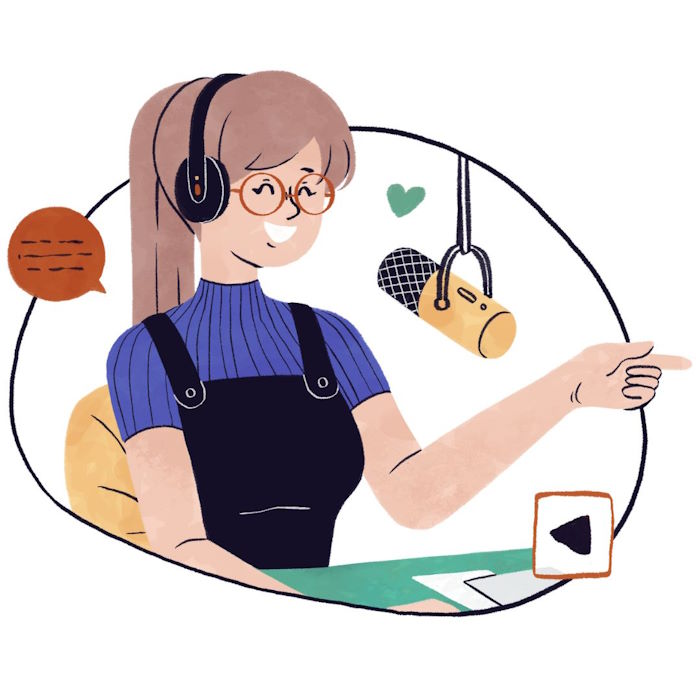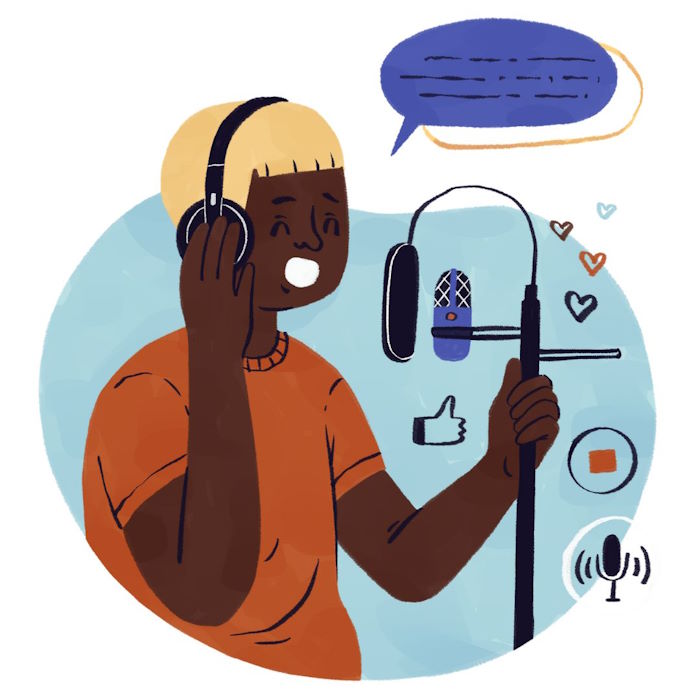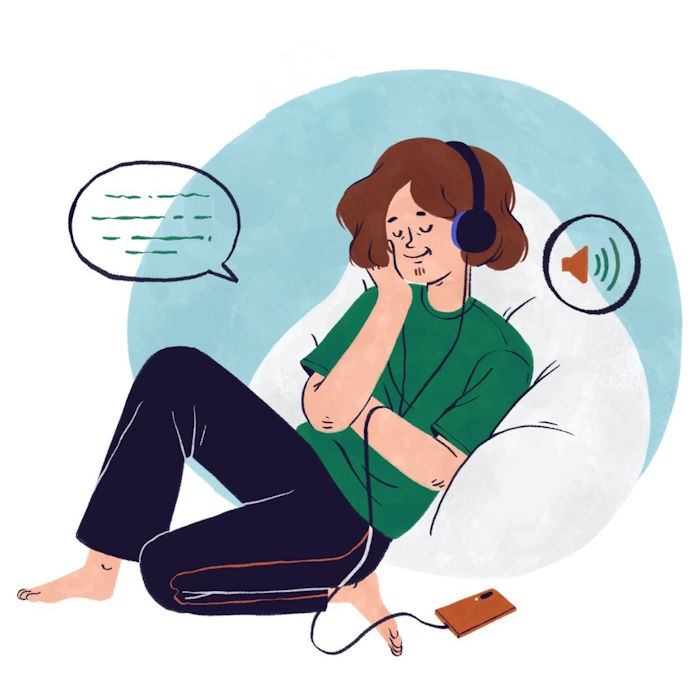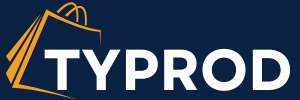In this blog post, I want to guide self-published authors through the exciting steps of how to publish an audiobook!
In recent years, audiobooks have surged in popularity, becoming a preferred format for many readers. Whether during a morning commute, a workout session, or a relaxing evening at home, audiobooks offer a convenient and immersive way to enjoy a good book.
In 2023 alone, the global audiobook market was valued at over $4 billion! For authors, this presents a golden opportunity to reach a broader audience and tap into a rapidly growing market.
Self-publishing an audiobook might seem daunting at first, but it’s a process that offers you the creative freedom you have come to love from your ebooks and the potential for higher royalties compared to traditional publishing routes. You maintain full control over every aspect of your audiobook, ensuring your work is presented exactly as you envision it.
In this guide, I will walk you through the entire process of self-publishing an audiobook. Whether you’re a seasoned author exploring a new format or a first-time writer eager to make your mark, this step-by-step guide will equip you with the knowledge and tools to bring your book to life in audio, from preparing your manuscript to navigating audiobook distribution and marketing.
The core questions you need to consider when you want to publish your first audiobook are these:
Are you set on self-publishing or would you prefer signing with a publisher who handles everything?
Do you believe you can self-narrate or do you want to find a professional narrator?
And lastly, how high is your budget?

Professional Narration vs. Self-Narration
If you are setting yourself the highest goals for your audiobook’s success, there is a very simple answer to the questions whether you should narrate your own book or hire a narrator.
Here it is: If your book is Nonfiction, audiobook listeners will enjoy hearing your words in your own voice! If you write Fiction, your future fans will expect a professional voice actor.
Now, I’ve been listening to audiobooks for many years and have been an audiobook blogger since 2018. In this time, I have seen many, many, maaaany audiobooks being released. Some to success, some to 4 ratings on Audible.
I also take note of things that happen int eh audiobook world. For example, a professional audiobook narrator turning author, recording her own books, and later on changing the narrator name to her pseudonym, so that author and narrator name on Audible won’t look the same anymore.
Why? Because audiobook fans have to be convinced that an author can do a good enough job with the audio version when it comes to Fiction books.
With Nonfiction, the expectations are entirely different. And Britney Spears’ memoir, for example, was initially criticized for not being read by the author herself. She later had to explain her reasoning behind this decision.
As you can see, there are clear (unwritten) rules in place who and how your audiobook should be narrated based on your genre!
Choosing the Right Narrator
One of the most critical decisions in audiobook production is choosing the right narrator. The narrator’s voice will be the bridge between your story and the listener, so it’s essential to make an informed choice. Professional narrators bring experience, vocal range, and technical skills to the table. They can bring characters to life and maintain listener engagement throughout.
You can ask your readers on social media for suggestions on audiobook narrators that would fit your characters!
The narrator’s voice should match the tone of your book and the age, location, and gender of your characters. Yes, audiobook narrator casting brings A/S/L back!
Look for narrators with experience in your book’s genre. Experienced narrators understand pacing, tone, and how to convey emotion effectively. They also come with their own set of fans who enjoy this book genre and the voice and will buy and promote your audiobook.
Ensure the narrator can accurately pronounce names, places, and specialized terminology. If your book has regional dialects or accents, choose a narrator who can deliver these authentically.
For your first audiobook, I would always recommend – as far as your budget allows – to have your most successful ebook recorded (no matter the original publishing date) and hire the most well-known narrator possible that fits your book! The promotional value of a popular voice actor will help immensely to introduce you to the audiobook audience.
Self-Narration
While self-narration may initially seem like a low-investment solution, it is anything but!
If you’re narrating a memoir or personal development book, listeners may prefer to hear the story in your voice, as it adds authenticity and a personal touch. But self-narration requires significant time, practice, and access to quality recording equipment.
As a listener, I want to hear a clear, engaging performance in high quality.
That means you need to buy good recording equipment or rent a recording studio. You also need to consider that every finished hour of audiobook requires far more than an hour to record. Especially in the beginning, you will find that you make a lot of mistakes or that your voice gives out at some point. That can easily lead to 2 hours just of recording time for 1 hour of finished audio.
Additionally, you will need to listen to your entire recording during the editing process and again to proof it.
If you consider self-narrating your Fiction audiobook, keep in mind that the promotion will lie on your shoulders alone! And consider using a narrator pseudonym so your author name and narrator name are not the same. You can still tell your fans that you recorded the book yourself (behind-the-scenes content will be excellent promotional material). But for Audible users coming across your book unexpectedly, it will be better this way as they won’t wonder whether your narration is good enough.

Preparing Your Manuscript for Audiobook Production
Now, whether or not you self-narrate, the audiobook requires a manuscript with prepared information, that will make the recording process easier.
While the content of your book remains the same, the way it’s presented in audio format can significantly impact the listener’s experience.
- Ensure your manuscript is thoroughly edited and formatted for audio. This includes removing any visual references like “see image below” and making sure the text flows smoothly when read aloud.
- Decide how to address any visual elements like maps, graphs, and images. Audiobooks are generally expected to be “unabridged”, meaning word-for-word the same as the ebook. So, it’s best practice to provide a supplemental PDF that listeners can download, instead of describing the visual elements.
- Create a pronunciation guide for difficult-to-pronounce words, names, or technical terms. Include phonetic spellings to help the narrator. If your book is dual Point of View and you work with two different narrators, audiobook listeners will expect both narrators to pronounce names the same!
- If you have footnotes or other text elements, consider how they should be handled in audio. A popular solution is, e.g., a short sound like a bell, that indicates a footnote. This should be explained at the very beginning of the audiobook.

Audiobook Production
Now that your manuscript is prepared and you’ve selected the perfect narrator, it’s time to move on to the actual production of your audiobook. This stage is where your written words are transformed into an engaging listening experience.
Audiobook production involves recording the narration, editing and polishing the audio, and adding final touches like introductory and closing credits. In this section, I want to show you the key steps in producing a high-quality audiobook.
Recording Process for Self-Narration
The recording process is the heart of audiobook production. Whether you’re working with a professional narrator or recording the audiobook yourself, creating a clean, clear, and captivating audio recording is essential.
Choosing a Recording Setup
- Professional Studio:
- Recording in a professional studio is often the best option for ensuring top-tier sound quality. Studios offer soundproofed environments, high-quality microphones, and expert sound engineers who can assist with the recording process.
- This option can be costly, but it’s ideal if you want a polished, professional-sounding audiobook.
- Home Studio:
- If you’re on a budget or prefer more flexibility, you can set up a home studio. While it may require an initial investment in equipment, recording at home gives you the freedom to work at your own pace and create more audiobooks in the future.
- Essential Equipment:
- Microphone: Invest in a high-quality condenser microphone, as it captures voice details and nuances better than basic USB mics.
- Pop Filter: A pop filter reduces plosive sounds (like “p” and “b”) that can cause distortion.
- Headphones: Use closed-back headphones to monitor the recording and avoid bleed-through.
- Audio Interface: An audio interface connects your microphone to your computer and improves sound quality.
- Recording Software: Programs like Audacity, GarageBand, or Adobe Audition are popular choices for recording and editing audiobooks.
- Soundproofing: Ensure your recording space is free from background noise. Use acoustic panels, blankets, or foam to reduce echoes and external sounds.
Recording Tips
- Warm up your voice before recording. Simple exercises like humming, lip trills, and tongue twisters can help.
- Consistency in pacing is crucial for listener engagement. Remind the narrator to maintain a steady pace, avoiding too-fast or too-slow reading.
- Keep an eye on the sound levels during recording to avoid clipping (distortion from sounds being too loud) or too-soft recordings that are hard to hear.
- Recording can be taxing on the voice. Take regular breaks and stay hydrated to maintain vocal quality throughout the session. Set your own pace so you can make it to the finish line!
Recording Process with a Professional Voice Actor
Hiring a professional can save you a lot of time and ensure your audiobook meets industry standards.
We start with creating a list of possible narrators based on recommendations and your own research into who is popular and active in your genre.
You can also consider doing open auditions on ACX if you want to go Audible-exclusive.
Once you find a suitable narrator, negotiate terms, including payment, deadlines, and any specific requirements you have for the narration.
Provide the narrator with a clean, final version of your manuscript. Include any pronunciation guides, character notes, or specific instructions for tone and pacing. The narrator will likely offer you a 15 minute sample of crucial scenes or lines so you can discuss any details and changes.
The narrator will then start the recording process. Further changes can usually not be made anymore in this stage.
Most audiobook narrators offer package deals to self-published authors that will provide you with a fully prepared, ready-to-distribute audiobook for a flat price.
You will receive a final edit to review.
Editing and Post-Production for Self-Narration
Once the recording is complete, the next step is editing and post-production. This process involves refining the audio to ensure it’s clear, polished, and professional-sounding. This process looks the same for professional narrators but you will usually not be involved in this unless you hire an audio engineer to take over these tasks from the audiobook narrator.
Editing the Audio
- Removing Mistakes: Edit out any mistakes, long pauses, or unnecessary sounds (like breaths or lip smacks). You can do this manually using audio editing software.
- Dealing with Background Noise: Use noise reduction tools to minimize any background noise that may have crept into the recording. Be careful not to overuse these tools, as they can sometimes make the audio sound unnatural.
- Balancing Audio Levels: Ensure that the audio levels are consistent throughout the recording. This includes making sure that quieter passages are audible and louder ones aren’t too jarring.
Mastering the Final Audio
- Equalization (EQ): Adjust the EQ settings to balance the bass, midrange, and treble frequencies, ensuring that the narrator’s voice sounds natural and clear.
- Compression: Apply compression to even out the dynamic range of the recording, making soft sounds louder and loud sounds softer, to create a more consistent listening experience.
- Normalization: Normalize the audio to ensure that the overall volume is at an appropriate level across the entire audiobook. Most platforms have specific loudness requirements (usually around -3dB), so make sure your audiobook meets these standards.
Quality Control
- Listen Through: After editing and mastering, listen through the entire audiobook to catch any remaining issues, such as audio glitches, pacing problems, or inconsistencies in the narration.
- Proofer: If possible, have a professional proofer review the audiobook. Fresh ears can help identify issues that you might have missed during the production process.
Adding Introductory and Closing Credits
Your audiobook isn’t complete without the proper introductory and closing credits. These sections bookend your content and provide essential information to the listener.
What to Include in the Introductory Credits:
- Title and Author: Clearly state the title of the book and your name as the author.
- Narrator’s Name: Introduce yourself as the narrator.
- Publisher Information: If you have a publishing entity, include its name here. For self-published authors, this might be your own brand or company.
Closing Credits:
- Thank You to Listeners: Acknowledge and thank your listeners for choosing your audiobook.
- Call to Action: Encourage listeners to leave a review, visit your website, or explore other works you’ve published.
- Additional Credits: Mention anyone who contributed to the production, such as editors, sound engineers, or other collaborators.
- Copyright Notice: Include a brief copyright notice, stating that all rights are reserved.

How to publish an Audiobook: Distribution
Once your audiobook is produced and ready to go, the next step is to distribute it so that listeners can find and purchase it. This step is the same whether you produce your own audiobook or work with a voice actor.
Choosing the right distribution platform is an important decision and I want you to carefully consider the pros and cons of each path.
Major Audiobook Distribution Channels
There are several platforms where you can distribute your audiobook, each with its own advantages and audience reach. Here’s an overview of the most popular options:
Audible (via ACX)
Audible, owned by Amazon, is the largest audiobook retailer, offering access to millions of listeners worldwide. When you publish through ACX (Audiobook Creation Exchange), your audiobook is distributed to Audible, Amazon, and iTunes.
Pros:
- Extensive reach and visibility
- Integrated marketing tools like Whispersync (more on this below)
Cons:
- Higher royalties that are in line with that other platforms offer (40%) only available if you choose exclusivity for 7 years
- No control over pricing
Findaway Voices
Findaway Voices was recently bought by Spotify and is a popular platform for wide distribution, allowing you to publish your audiobook across multiple retailers, including Everand, Spotify, Kobo, public libraries, and many more.
Pros:
- Wide distribution with control over pricing and non-exclusivity.
- Option to publish in public libraries.
Cons:
- Lower royalties on some platforms compared to Audible exclusivity.
- Requires more effort in managing multiple platforms.
Author’s Republic
Author’s Republic is a distribution platform that offers access to over 50 retail and library partners, including Audible, Everand, and Google Play.
Pros:
- Wide distribution across multiple platforms with a single upload.
- Non-exclusive agreement, allowing more flexibility.
Cons:
- Lower royalties on some platforms compared to Audible exclusivity.
- Less control over individual platform settings and pricing.
Royalty Share vs. Publisher vs. Self-Publishing
As you are probably aware, hiring a narrator is a huge investment. You have two alternatives to that path. One is pitching to an audiobook publisher. The other is royalty share through Audible ACX. Let’s take a look at the pros and cons of each option.
Royalty Share (ACX)
You partner with a narrator on ACX, who agrees to narrate and produce your book in exchange for a share of the royalties. This option is appealing for authors who want to minimize upfront costs.
Pros:
- No upfront costs for narration.
- Suitable for authors with limited budgets.
Cons:
- You only earn 20% royalties if you choose exclusivity.
- You’re locked into a 7-year contract with ACX, a long time until you could consider re-recording the audiobook.
- If your audiobook is a success, you might end up paying the narrator more than you would have in an upfront payment.
- If your audiobook is not a success, you invested a lot of time that you could have used to write.
- You don’t have the promotional pull of a big-name narrator.
- Many authors recommend against royalty share.
Audiobook Publisher
If you work with an audiobook publisher like Tantor, Podium, or Dreamscape, they typically handle all aspects of audiobook production and distribution. You receive an advance and a share of the royalties once you earn out.
Pros:
- No upfront costs and minimal involvement in production.
- Professional production.
- Wide distribution through the publisher’s networks.
- Promotion by the publisher.
Cons:
- Lower royalties (often around 10-25%).
- Loss of creative control and potential delays in production.
- Publishers only take on very successful ebooks for audio production.
Self-Publishing + Hiring a Narrator
You fully self-publish your audiobook, including hiring and paying a narrator upfront through a negotiated one-time fee. You retain full control over the production and distribution.
Pros:
- Highest potential royalties (up to 40-45% on ACX exclusive or up to 80% on other platforms).
- Full creative control and ownership of your audiobook, including the narrator choice.
- Flexibility to distribute on multiple platforms.
Cons:
- High upfront costs for hiring a professional narrator.
- Responsibility for managing all aspects of production and distribution.
Going Wide vs Audible Audible Exclusive (with Whispersync)
One important consideration, whether you are looking into ACX royalty share or self-publishing, is if you want to publish wide or go Audible exclusive.
A viable strategy many audiobook authors use is to publish Audible exclusive, but make full use of Amazon Whispersync. Audiobook fans often have a Kindle Unlimited subscription only to buy cheap Audible books.
When I borrow an ebook through Kindle Unlimited, I can buy the Whispersynced audiobook for $7.49. That’s only half the value of an Audible credit!
Whispersync for Voice allows listeners to switch seamlessly between reading an ebook and listening to the audiobook version without losing their place. This feature is particularly popular with readers who enjoy both formats and audiobook fans who appreciate the cheap audio upgrade prices.
In order for your audiobook to be eligible for Whispersync, it needs to be word-for-word precisely the same as the ebook text and structure. You can’t actively opt in or out of Whispersync.
Benefits of Going Audible Exclusive with Whispersync
- Higher Royalties: If you choose to publish exclusively with Audible through ACX, you can earn up to 40% royalties on sales, compared to 25% if you choose non-exclusivity.
- Whispersync Integration: This can potentially boost sales of both formats. Books with Whispersync often attract more attention from readers who enjoy this feature, as well as audiobook-exclusive listeners who are on the lookout for deals.
- Promotional Opportunities: Exclusive audiobooks may be eligible for special promotions and marketing efforts by Audible, increasing visibility.
Benefits of Going Wide
Expanded Distribution:
- By publishing wide, you broaden your potential audience, giving you access to listeners who may prefer different platforms or have subscriptions with services other than Audible.
- By making your first audiobook available to be borrowed through digital library subscriptions like Everand, Hoopla, or Spotify, more listeners may be willing to take a chance on your book and spread the word.
Flexibility and Freedom:
- When you publish wide, you’re not tied to a long-term exclusivity contract. This means you can explore and experiment with different platforms and marketing strategies to see what works best for your audiobook. If a new platform emerges or an existing one offers a better deal, you can easily pivot to take advantage of these opportunities.
- You retain full control over your pricing, distribution, and promotional efforts, allowing you to optimize your strategy for maximum impact.
Diversified Income Streams:
- Publishing wide allows you to diversify your income by earning royalties from multiple sources. This reduces your dependency on a single platform like Audible, which can be especially important if there are changes in platform policies, royalty rates, or market dynamics.
- By being available on multiple platforms, your audiobook is more likely to be discovered by various types of listeners, from those who browse library catalogs to those who actively avoid Audible and prefer ethical subscriptions like LibroFM.
Make sure you also check out my 10 Audiobook Creation Essentials for more in-depth tips to creating a successful audiobook!

Eline Blackman (pronouns: she/they) fell in love with books as a child – with being read to and reading herself. 10 years ago, she bought her first Audible book. It was love at first listen! An average of 250 audiobooks per year has become the new normal and you will rarely see Eline without a wireless earbud. Romance and Fantasy are the go-to genres for this audiobook fan.
Audio Authors /













